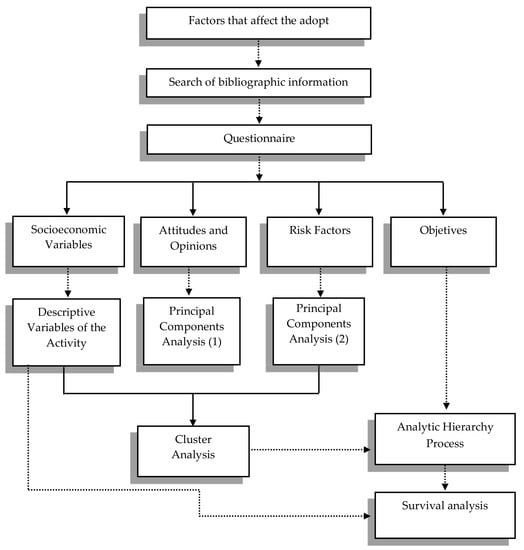Determinant Factors of the Adoption of Improved Maize Seeds in Southern Mexico: A Survival Analysis Approach
Abstract
:1. Introduction
2. Adoption of Improved Seeds
3. Materials and Methods
3.1. Study Area
3.2. Definition of Sample Size
3.3. Methodological Framework
3.4. Empirical Application
- (1)
- (2)
- (3)
- (4)
- External factors (E): external factors like media contact, technical assistance, agricultural policies, government programs, access and overtures to universities or research institutions [61].
- (5)
- (6)
4. Results
4.1. Descriptive Analysis of Hypothetical Variables
4.2. Econometric Analysis
5. Conclusions
Supplementary Materials
Author Contributions
Funding
Acknowledgments
Conflicts of Interest
References
- SIAP. Avances de Siembras y Cosechas por Estado y Año Agrícola; Secretaría de Agricultura, Ganadería, Desarrollo Rural, Pesca y Alimentación: Mexico City, Mexico, 2016; Available online: http://siap.gob.mx (accessed on 25 March 2016).
- FAOSTAT. Organización de las Naciones Unidas Para la Alimentación y la Agricultura (FAO). 2016. Available online: http://faostat.fao.org (accessed on 9 July 2016).
- Harrison, P. Agricultura Mundial: Hacia los Años 2015/2030. Dirección de Información de la FAO. 2002. Available online: http://www.fao.org/docrep/004/y3557s/y3557s06.htm (accessed on 20 January 2017).
- Nelson, C.; Rosegrant, W.; Koo, J.; Robertson, R.; Sulser, T.; Zhu, T.; Ringler, C.; Msangi, S.; Palazzo, A.; Batka, M.; et al. Cambio Climático: El impacto en la Agricultura y los Costos de Adaptación; Política Alimentaria; FAO: Washington, DC, USA, 2009. [Google Scholar]
- FAO. Alimentación y Agricultura Sostenible; FAO: Washington, DC, USA, 2017; Available online: www.fao.org/sustainability/es/ (accessed on 13 July 2017).
- Turrent, A.; Wise, T.; Garvey, E. Mexican Rural Development Research Reports; Wilson Center: Washington, DC, USA, 2012. [Google Scholar]
- Schroeder, C.; Onyango, K.; Ranabhat, N.; Jick, N.; Parzies, H.; Gemenet, D. Potentials of hybrid maize varieties for small-holder farmers in Kenya: A review based on swot analysis. Afr. J. Food Agric. Nutr. Dev. 2013, 13. Available online: https://www.ajol.info/index.php/ajfand/article/view/87480 (accessed on 15 April 2016).
- Luna, B.; Hinojosa, M.; Ayala, O.; Castillo, F.; Mejía, J. Perspectivas de desarrollo de la industria semillera de maíz en México. Rev. Fitotec. Mex. 2012, 35, 1–7. [Google Scholar]
- Snics. Catálogo Nacional de Variedades Registradas; SAGARPA: Mexico City, Mexico, 2018. [Google Scholar]
- Rodríguez, R.; Donnet, L.; Jácome, S.; Jolalpa, J.; López, D.; Domínguez, C.; Moctezuma, G.; Espinoza, J.; Cepeda, J.; Rentería, I.; et al. Caracterización de la Demanda de Semillas Mejoradas de Maíz en Tres Agro-Ambientes de Producción de Temporal en México, 1st ed.; Rodrígez, R., Donnet, L., Eds.; Instituto Nacional de Investigaciones Forestales, Agrícolas y Pecuarias: México City, Mexico, 2015; 170p. [Google Scholar]
- Beyene, D.; Kassie, M. Speed of adoption of improved maize varieties in Tanzania: An application of duration analysis. Technol. Forecast. Soc. Chang. 2015, 96, 298–307. [Google Scholar] [CrossRef]
- López, M.; Filipello, M. Maize seed industries revisited: Emerging roles of the public and private sectors. In Primera Parte de 1993–1994 CIMMYT World Maize Facts and Trends: Maize Seed Industries Maize Seed Industries Revisited: Emerging Roles of the Public and Private Sectors; CIMMYT: Mexico City, Mexico, 1994. [Google Scholar]
- CIMMYT. La Adopción de Tecnologías: Guía Para el Diseño de Encuestas; de Economía, C.P., Ed.; CIMMYT: México City, Mexico, 1993; 88p. [Google Scholar]
- Ghadim, A.; Pannell, D.; Burton, M.P. Risk, uncertainty, and learning in adoption of a crop innovation. Agric. Econ. 2005, 33, 1–9. [Google Scholar] [CrossRef]
- Klein, J.; Moeschberger, M. Survival Analysis of Failure Data; Wiley: New York, NY, USA, 1997. [Google Scholar]
- Hattam, C.E.; Lacombe, D.J.; Holloway, G.J. Organic certification, export market access and the impacts of policy: Bayesian estimation of avocado smallholder “times-to-organic certification” in Michoacán Mexico. Agric. Econ. 2012, 43, 441–457. [Google Scholar] [CrossRef]
- De Cock, L. Determinants of organic farming conversion. In Proceedings of the XI International Congress of the European Association of Agricultural Economists (No 24675), Copenhagen, Denmark, 24–27 August 2005; European Association of Agricultural Economists: Uppsala, Sweden, 2015. [Google Scholar]
- Sánchez-Toledano, B.; Kallas, Z.; Gil, J. Importancia de los objetivos sociales, ambientales y económicos de los agricultores en la adopción de maíz mejorado en Chiapas. Rev. Fac. Cienc. Agrar. Univ. Nac. Cuyo 2017, 49, 269–287. [Google Scholar]
- Herrera, E.; Macías, A.; Díaz, R.; Valadez, M.; Delgado, A. Uso de semilla criolla y caracteres de mazorca para la selección de semilla de maíz en México. Rev. Fitotec. Mex. 2002, 25, 17–23. [Google Scholar]
- Seré, C.; Estrada, J.E.F. Estudios de adopción e impacto en pasturas tropicales. In Investigación con Pasturas en Fincas CIAT; Centro Internacional de Agricultura Tropical (CIAT): Palmira, Colombia, 1990. [Google Scholar]
- Welch, F. Education in production. Ecoonomy 1970, 8, 39–59. [Google Scholar] [CrossRef]
- Knowler, D.; Bradshaw, B. Farmers’ adoption of conservation agriculture: A review and synthesis of recent research. Food Policy 2007, 32, 25–48. [Google Scholar] [CrossRef]
- Rigby, D.; Young, T.; Burton, M. The development of and prospects for organic farming in the UK. Food Policy 2001, 26, 599–613. [Google Scholar] [CrossRef]
- Hazell, P.; Wood, S. Divers of change in global agriculture. Philos. Trans. R. Soc. B 2008, 363, 495–515. [Google Scholar] [CrossRef] [PubMed]
- Abebaw, D.; Belay, K. Factors influencing adoption of high yielding maize varieties in Southwestern Ethiopia: An application of logit. Q. J. Int. Agric. 2001, 401, 49–167. [Google Scholar]
- Hogeland, A. The economics culture of, U.S. agricultural cooperatives. Cult. Agric. 2016, 28, 67–79. [Google Scholar] [CrossRef]
- Feder, G.; Just, R.; Zilberman, D. Adoption of agricultural innovations in developing countries: A survey. Econ. Dev. Cult. Chang. 1985, 33, 55–298. [Google Scholar] [CrossRef]
- Chilonda, P.; Van Huylenbroeck, G. Attitudes towards and uptake of veterinary services by small-scale cattle farmers in Eastern province Zambia. Outlook Agric. 2001, 30, 218–231. [Google Scholar] [CrossRef]
- Córdova, H.; Castellanos, S.; Bolaños, J. Veinticinco años de mejoramiento en los sistemas de maíz en Centroamérica: Logros y estrategias hacia el año 2000. Agron. Mesoam. 2002, 13, 73–84. [Google Scholar] [CrossRef]
- Challinor, A.J.; Koehler, A.-K.; Ramirez-Villegas, J.; Whitfield, S.; Das, B. Current warming will reduce yields unless maize breeding and seed systems adapt immediately. Nat. Clim. Chang. 2016, 6, 954–958. [Google Scholar] [CrossRef] [Green Version]
- Sánchez-Toledano, B.; Kallas, Z.; Gil, J. Farmer preference for improved corn seeds in Chiapas, Mexico: A choice experiment approach. Span. J. Agric. Res. 2017, 15, e0116. [Google Scholar] [CrossRef]
- Cofece. Comisión Federal de Competencia Económica. Empresas Semilleras en México, 2016. Available online: www.cofece.mx (accessed on 25 September 2018).
- Espinosa, A.; Tadeo, M.; Turrent, A. Concentración de la Oferta de Semillas Mejoradas de Maíz. 2010. Available online: http://www.jornada.unam.mx/2010/03/13/oferta.html (accessed on 25 September 2018).
- García, J.; Ramírez, R. El mercado de la semilla mejorada de maíz (Zea mays L.) en México: Análisis del saldo comercial por entidad federativa. Rev. Fitotec. Mex. 2014, 37, 69–77. [Google Scholar]
- Fox, J.; Haight, L. La política agrícola mexicana: Metas múltiples e intereses en conflicto. In Subsidios Para la Desigualdad. Las Políticas Públicas del Maíz en México a Partir del Libre Comercio; Dissa Impresores: México City, Mexico, 2010. [Google Scholar]
- Rivera, A.; Romero, H. Evaluación del nivel de transferencia y adopción de tecnología en el cultivo de caña de azúcar en Córdoba, Veracruz, México. Av. Investig. Agropecu. 2003, 21, 20–40. [Google Scholar]
- Lee, D. Agricultural Sustainability and Technology Adoption: Issues and Policies for Developing Countries. Am. J. Agric. Econ. 2005, 87, 1325–1334. [Google Scholar] [CrossRef]
- Chirwa, E. Adoption of fertiliser and hybrid seeds by smallholder maize farmers in Southern Malawi. Dev. S. Afr. 2005, 22, 1–12. [Google Scholar] [CrossRef]
- Alcon, F.; De Miguel, D.; Burton, M. Duration analysis of adoption of drip irrigation technology in southeastern Spain. Technol. Forecast. Soc. Chang. 2011, 78, 991–1001. [Google Scholar] [CrossRef]
- King, A. Diez años con el TLCAN. Revisión de la Literatura y Análisis de las Respuestas de los Agricultores de Sonora y Veracruz, México; (Informe Especial) Report No.: 07-01; CIMMYT: México City, Mexico, 2007. [Google Scholar]
- CONEVAL. Evolución de las Líneas de Bienestar y d ela Canasta Alimentaria. 2016. Available online: http://www.coneval.org.mx/Medicion/MP/Paginas/Lineas-de-bienestar-y-canasta-basica.aspx http://www.coneval.gob.mx/Informes/Coordinacion/INFORMES_Y_PUBLICACIONES_PDF/Construccion_lineas_bienestar.pdf (accessed on 1 July 2016).
- Gobierno del Estado de Chiapas. Chiapas Nos Une. 2015. Available online: http://www.chiapas.gob.mx/ubicación (accessed on 26 January 2015).
- INEGI. Encuesta Nacional Agropecuaria ENA 2014. Resultados. 2015. Available online: http://www.inegi.org.mx/est/contenidos/proyectos/encuestas/agropecuarias/ena/ena2014/doc/pre sentacion/ena2014_pres.pdf (accessed on 27 July 2016).
- Fundación Produce Chiapas, A.C. Agenda Estatal de Innovación. In Programa de Desarrollo de Capacidades, Innovación Tecnológica y Extensionismo Rural Componente: Innovación y Transferencia de Tecnología; Fundación Produce Chiapas, A.C.: Tuxtla Gutiérrez, Mexico, 2011; p. 124. [Google Scholar]
- Guevara, F.; Rodríguez, L.A.; Ovando, J.; Gómez, H.; Ocaña, M.D.J.; y Camacho, T.C. Implicaciones socioeconómicas y energéticas del uso y manejo de rastrojo en la región Frailesca, Chiapas. In Rastrojos: Manejo, uso y Mercado en el Centro y sur de México; Centro de Investigación Regional Norte Centro: México City, Mexico, 2013; pp. 37–91. [Google Scholar]
- Ceieg. Secretaria de Planeación, Gestión Pública y Programa de Gobierno. 2015. Available online: http://www.ceieg.chiapas.go (accessed on 17 March 2016).
- McWilliams, B.; Zilberman, D. Time of Technology Adoption and Learning by Using. Econ. Innov. New Technol. 1996, 4, 139–154. [Google Scholar] [CrossRef]
- Lawless, F. Statistical Models and Methods for Lifetime Data, 2nd ed.; Wiley: New York, NY, USA, 1982; 664p. [Google Scholar]
- Lancaster, K. The Econometric Analysis of Transition Data, 1st ed.; Cambrige University Press: Cambridge, UK, 1992; 352p. [Google Scholar]
- Lancaster, K. The econometric analysis of transition data. Econ. J. 1992, 102, 165–166. [Google Scholar]
- Bland, M.; Altman, G. Survival probabilities (the Kaplan-Meier method). Br. Med. J. 1998, 317, 1572–1580. [Google Scholar] [CrossRef]
- Cox, D. Regression models and life tables. J. R. Stat. Soc. 1972, 34, 187–220. [Google Scholar]
- Allison, P.D. Discrete-time methods for the analysis of event histories. In Sociological Methodology Jossey-Leinhardt; Bass Publishers: San Francisco, CA, USA, 1982; pp. 61–98. [Google Scholar]
- Feder, G.; Umali, D. The adoption of agricultural innovations. Technol. Forecast. Soc. Chang. 1993, 43, 215–239. [Google Scholar] [CrossRef]
- Bekele, A.; Abebe, Y. Analysis of adoption spell of hybrid maize in the Central Rift Valley, Oromyia National Regional State of Ethiopia: A duration model approach. J. Agric. Econ. Dev. 2014, 4, 207–213. [Google Scholar] [CrossRef]
- Mwangi, H.W.; Kihurani, A.W.; Wesonga, J.M.; Ariga, E.S.; Kanampiu, F. Factors influencing adoption of cover crops for weed management in Machakos and Makueni counties of Kenya. Eur. J. Agron. 2015, 69, 1–9. [Google Scholar] [CrossRef]
- Dhakal, A.; Cockfield, G.; Maraseni, T.N. Deriving an index of adoption rate and assessing factors affecting adoption of an agroforestry-based farming system in Dhanusha District, Nepal. Agrofor. Syst. 2015, 89, 645–661. [Google Scholar] [CrossRef]
- Islam, A.; Barman, B.; Murshed-e-Jahan, K. Adoption and impact of integrated rice-fish farming system in Bangladesh. Aquaculture 2015, 447, 76–85. [Google Scholar] [CrossRef]
- Kallas, Z.; Serra, T.; Gil, J. Farmers’ objectives as determinants of organic farming adoption: The case of Catalonian vineyard production. Agric. Econ. 2010, 41, 409–423. [Google Scholar] [CrossRef]
- Smale, M.; Richard, J.; Howard, L. Land allocation in HYV adoption models: An investigation of alternative explanations. Agric. Am. J. Econ. 1994, 76, 535–546. [Google Scholar] [CrossRef]
- Weber, C.; McCann, L. Adoption of nitrogen-efficient technologies by, U.S. corn farmers. J. Environ. Qual. 2015, 44, 391–401. [Google Scholar] [CrossRef] [PubMed]
- Asfaw, S.; Shiferaw, B.; Simtowe, F.; Lipper, L. Impact of modern agricultural technologies on smallholder welfare: Evidence from Tanzania and Ethiopia. Food Policy 2012, 37, 283–295. [Google Scholar] [CrossRef]
- Ghimire, R.; Wen-Chi, H.; Shrestha, B. Factors affecting adoption of improved rice varieties among rural farm households in Central Nepal. Rice Sci. 2015, 22, 35–43. [Google Scholar] [CrossRef]
- Cavallo, E.; Ferrari, E.; Bollani, L.; Coccia, M. Attitudes and behaviour of adopters of technological innovations in agricultural tractors: A case study in Italian agricultural system. Agric. Syst. 2014, 130, 44–54. [Google Scholar] [CrossRef]
- Howley, P.; Buckley, C.; Donoghue, C.O.; Ryan, M. Explaining the economic “irrationality” of farmers’ land use behaviour: The role of productivist attitudes and non-pecuniary benefits. Ecol. Econ. 2015, 109, 186–193. [Google Scholar] [CrossRef]
- Nandi, R.; Gowdru, N.; Bokelmann, W.; Dias, G. Smallholder organic farmer’s attitudes, objectives and barriers towards production of organic fruits and vegetables in India: A multivariate analysis. Emir. J. Food Agric. 2015, 17, 396–406. [Google Scholar] [CrossRef]
- Hair, J.; Anderson, E.; Tatham, R.; Black, W. Multivarte Data Analysis; Internationa Prentice-Hall International Inc.: Upper Saddle River, NJ, USA, 1998; 730p. [Google Scholar]
- Valdivia, R.; Espinosa, A.; Tadeo, M.; Caro, F.; Aguilar, J.; Vidal, V.; Ruelas, P.; López, G. “Cora 2012”: Híbrido intervarietal de maíz para Nayarit y regiones similares. Rev. Mex. Cienc. Agríc. 2015, 6, 417–420. [Google Scholar]
- Valdivia, R.; Caro, F.; Ortiz, M.; Betancourt, A.; Ortega, A.; Vidal, V.; Espinosa, A. Desarrollo participativo de híbridos sintéticos de maíz y producción de semilla por agricultores. Agric. Téc. Méx. 2007, 33, 135–143. [Google Scholar]
- Hellin, J.; Bellon, M. Manejo de semillas y diversidad del maíz—AgriCultures Network. Leisa Rev. Agroecol. 2007, 23, 9–11. [Google Scholar]
- Salazar, J.; Rivera, H.; Arévalo, S.; Guevara, A.; Mald, G.; Raascón, Q. Calidad del nixtamal y su relación con el ambiente de cultivo del maíz. Fitotec. Mex. 2015, 38, 67–73. [Google Scholar]
- Birol, E.; Smale, M.; Yorobe, J. Bi-modal preferences for bt maize in the Philippines: A latent class model. AgBioForum 2012, 15, 175–190. [Google Scholar]
- Li, J.; Lammerts, E.; Jiggins, J.; Leeuwis, C. Farmers’ adoption of maize (Zea mays, L.) hybrids and the persistence of landraces in Southwest China: Implications for policy and breeding. Genet. Resour. Crop Evol. 2012, 59, 1147–1160. [Google Scholar] [CrossRef]
- Sibiya, J.; Tongoona, P.; Derera, J.; Makandaa, I. Farmers’ desired traits and selection criteria for maize varieties and their implications for maize breeding: A case study from Kwazulu-Natal Province, South Africa. J. Agric. Rural Dev. Trop. Subtrop. 2013, 114, 39–49. [Google Scholar]
- Veisi, H.; Liaghati, H.; Alipour, A. Developing an ethics-based approach to indicators of sustainable agriculture using analytic hierarchy process (AHP). Ecol. Indic. 2016, 60, 644–654. [Google Scholar] [CrossRef]
- Asrat, S.; Yesuf, M.; Carlsson, F.; Wale, E. Farmers’ preferences for crop variety traits: Lessons for on-farm conservation and technology adoption. Ecol. Econ. 2010, 69, 2394–2401. [Google Scholar] [CrossRef]
- Kamara, A.; Kureh, I.; Menkir, A.; Kartung, P.; Tarfa, B.; Amaza, P. Participatory on-farm evaluation of the performance of drought-tolerant maize varieties in the Guinea savannas of Nigeria. Int. J. Food Agric. Environ. 2006, 4, 192–196. [Google Scholar]
- Yúnez, A.; Barceinas, F. The Agriculture of Mexico after Ten Years of Nafta Implementation; Documentos de Trabajo; Banco Central de Chile: Santiago, Chile, 2004. [Google Scholar]
- Kiefer, N. Economic duration data and hazard functions. J. Econ. Lit. 1988, 26, 646–679. [Google Scholar]
- Nazli, H.; Smale, M. Dynamics of variety change on wheat farms in Pakistan: A duration analysis. Food Policy 2016, 59, 24–33. [Google Scholar] [CrossRef]
- Rogers, E. Diffusion of Innovations, 4th ed.; T.F. Press: New York, NY, USA, 1995. [Google Scholar]
- Abdulai, A.; Huffman, E. The diffusion of new agricultural technologies: The case of crossbred-cow technology in Tanzania. Am. J. Agric. Econ. 2005, 87, 645–659. [Google Scholar] [CrossRef]
- Negatu, W.; Parikh, A. The impact of perception and other factors on the adoption of agricultural technology in the Moret and Jiru Woreda (district) of Ethiopia. Agric. Econ. 1999, 21, 205–216. [Google Scholar] [CrossRef]
- Rogers, E.M. Lessons for guidelines from the diffusion of innovations. Joint Comm. J. Quality Patient Saf. 1995, 21, 324–328. [Google Scholar] [CrossRef]
- Parra, C.; Calatrava, R. Factors related to the adoption of organic farming in Spanish olive orchards. Span. J. Agric. Res. 2005, 3, 5–16. [Google Scholar] [CrossRef]
- Gaytan, R.; Reyes, L.; Martínez, M.; Mayek, N.; Padilla, S.Y.; Luna, F. Seed and forage yield depression of maize hybrids in advanced generations. Agric. Téc. Méx. 2005, 31, 165–175. [Google Scholar]
- Lunduka, R.; Fisher, M.; Snapp, S. Could farmer interest in a diversity of seed attributes explain adoption plateaus for modern maize varieties in Malawi? Food Policy 2012, 37, 504–510. [Google Scholar] [CrossRef]
- Kafle, B. Determinants of adoption of improved maize varieties in developing countries: A review. Int. Res. J. Appl. Basic Sci. 2010, 1, 1–7. [Google Scholar]
- Ouma, J.; Bett, E.; Mbataru, P. Drivers of adoption of Improved Maize varieties in Moist Transitional zone of Eastern Kenya. J. Econ. Sustain. Dev. 2014, 5, 1700–2222. [Google Scholar]
- Simtowe, F.; Zeller, M.; Diagne, A. The impact of credit constraints on the adoption of hybrid maize in Malawi. Rev. Agric. Environ. Stud. 2009, 90, 5–22. [Google Scholar]
- Mignouna, D.; Manyong, V.; Rusike, J.; Mutabazi, K.; Senkondo, E. Determinants of Adopting Imazapyr-Resistant Maize Technologies and its Impact on Household Income in Western Kenya. J. Agrobiotechnol. Manag. Econ. 2011, 14, 7. [Google Scholar]
- Nadal, A.; Wise, T. Working Group on Development and Environment in the Americas the Environmental Costs of Agricultural Trade Liberalization: Mexico-U.S. Maize Trade under NAFTA; Discussion Paper Number 4; Working Group on Development and Environment in the Americas; 2004; Available online: https://www.researchgate.net/publication/237616381_The_Environmental_Costs_of_Agricultural_Trade_Liberalization_Mexico-S_Maize_Under_NAFTA_Working_Group_on_Environment_and_Development_in_the_Americas_March_29-30_2004 (accessed on 20 September 2018).
- Nadal, A. The Environmental and Social Impacts of Economic Liberalization on Corn Production in Mexico; Estudio Realizado por Oxfam GB y WWF International: Oxford, UK, 2000. [Google Scholar]
- Di-Falco, S.; Bulte, E. A dark side of social capital? kinship, consumption, and savings. J. Dev. Stud. 2011, 47, 1128–1151. [Google Scholar] [CrossRef]
- Mafuru, J.; Kileo, R.; Verkuijl, H.; Mwangi, W.; Anandajaysekeram, P.; Moshi, A. Adoption of Maize Production Technologies in the Lake Zone of Tanzania; CIMMYT: México City, Mexico, 1999; 39p. [Google Scholar]
- Noltze, M.; Schwarze, S.; Qaim, M. Understanding the adoption of system technologies in smallholder agriculture: The system of rice intensification (SRI) in Timor Leste. Agric. Syst. 2012, 108, 64–73. [Google Scholar] [CrossRef]
- Dibba, L.; Zeller, M.; Diagne, A.; Nielsen, T. How accessibility to seeds affects the potential adoption of an improved rice variety: The case of the new rice for Africa (NERICA) in the Gambia. Q. J. Int. Agric. 2015, 54, 33–58. [Google Scholar]
- Kallas, Z.; Serra, T.; Gil, J. Farmer’s objectives as determinant factors of organic farming adoption. In Proceedings of the 113th EAAE Seminar “A Resilient European Food Industry and Food Chain in a Challenging World”, Chania, Greece, 3–6 September 2009; p. 19. [Google Scholar]
- Becerril, J.; Abdulai, A. The Impact of improved maize varieties on poverty in Mexico: A propensity score-matching approach. World Dev. 2010, 38, 1024–1035. [Google Scholar] [CrossRef]
- Brick, K.; Visser, M. Risk preferences, technology adoption and insurance uptake: A framed experiment. J. Econ. Behav. Organ. 2015, 118, 383–396. [Google Scholar] [CrossRef]
- Albert, S.; Duffy, J. Differences in risk aversion between young and alder adults. Neurosci. Neuroecon. 2012, 2, 3–9. [Google Scholar] [CrossRef] [PubMed]
- Dohmen, T.; Falk, A.; Huffman, D.; Sunde, U. Are risk aversion and impatience related to cognitive ability? Am. Econ. Rev. 2010, 100, 1238–1260. [Google Scholar] [CrossRef]
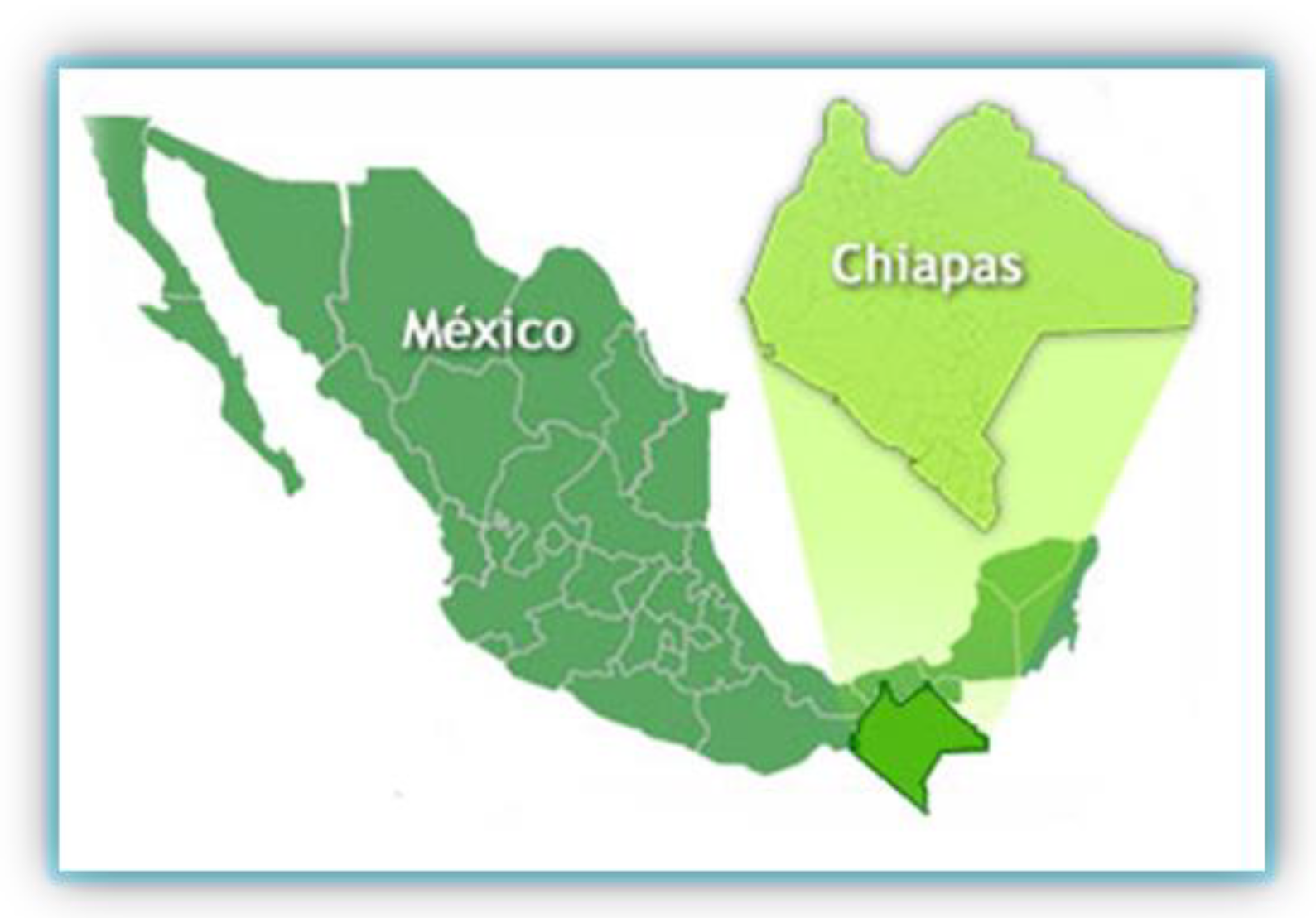

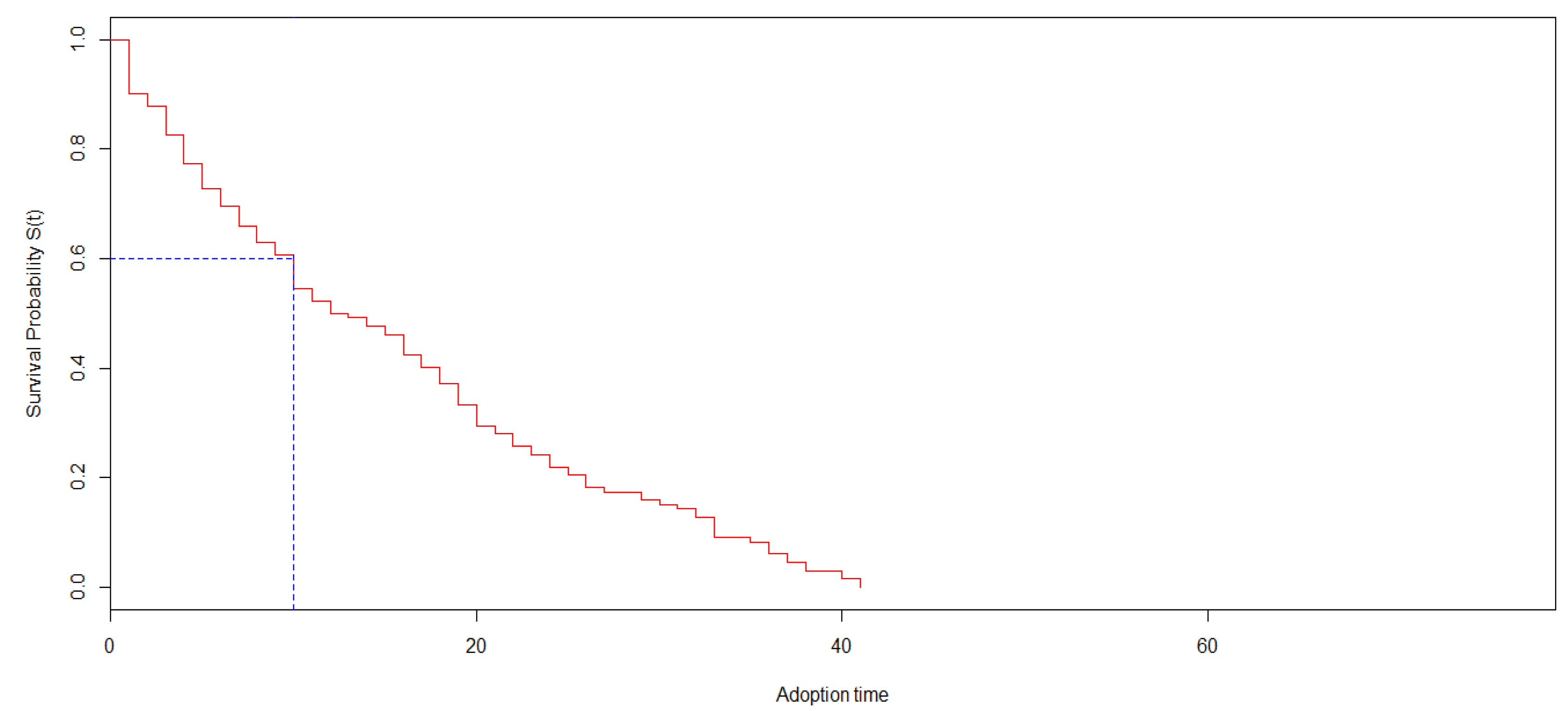

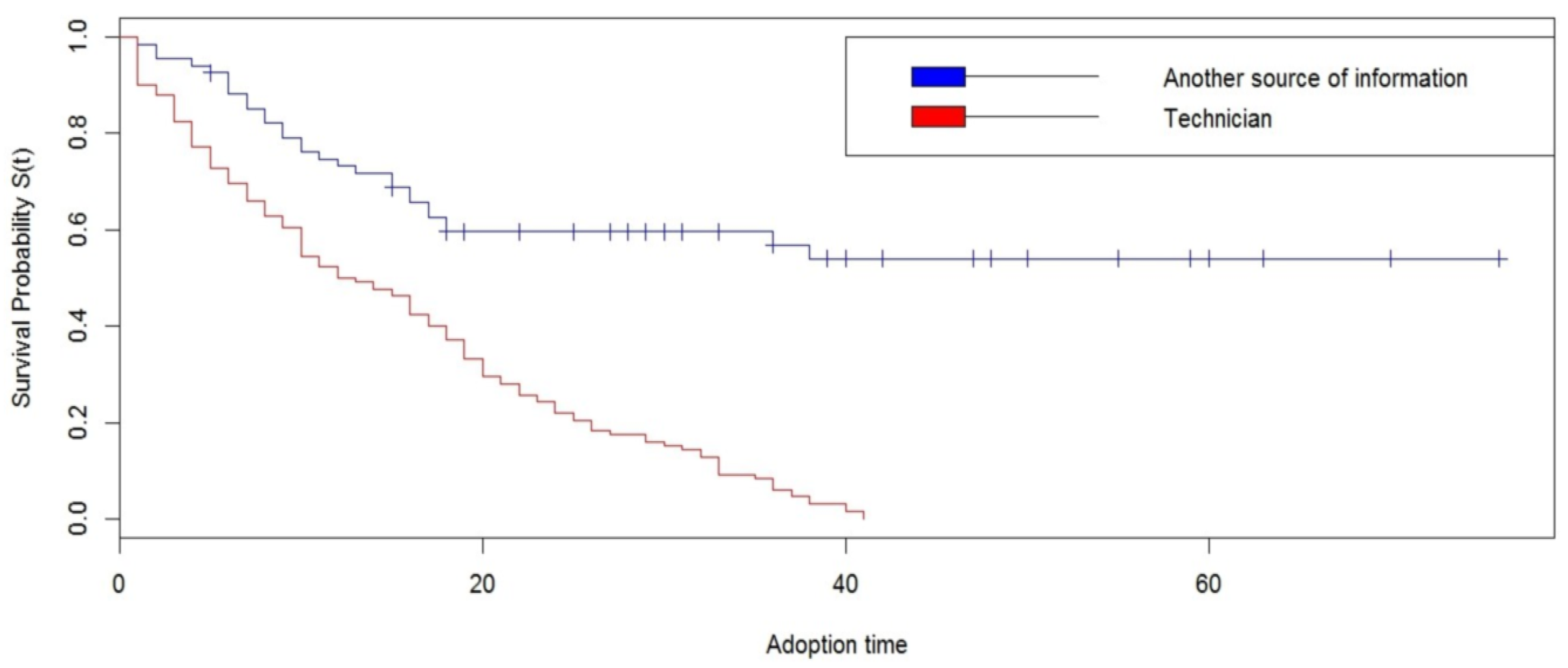
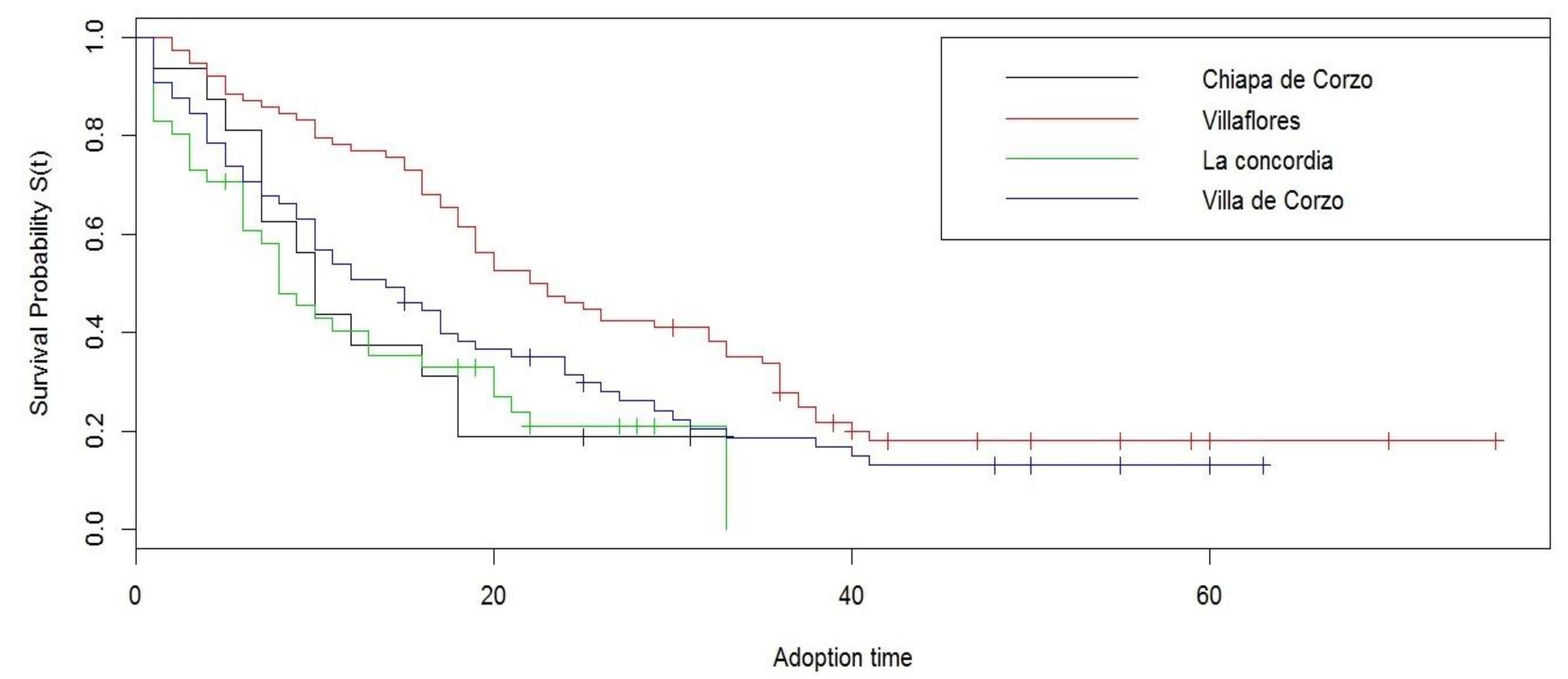
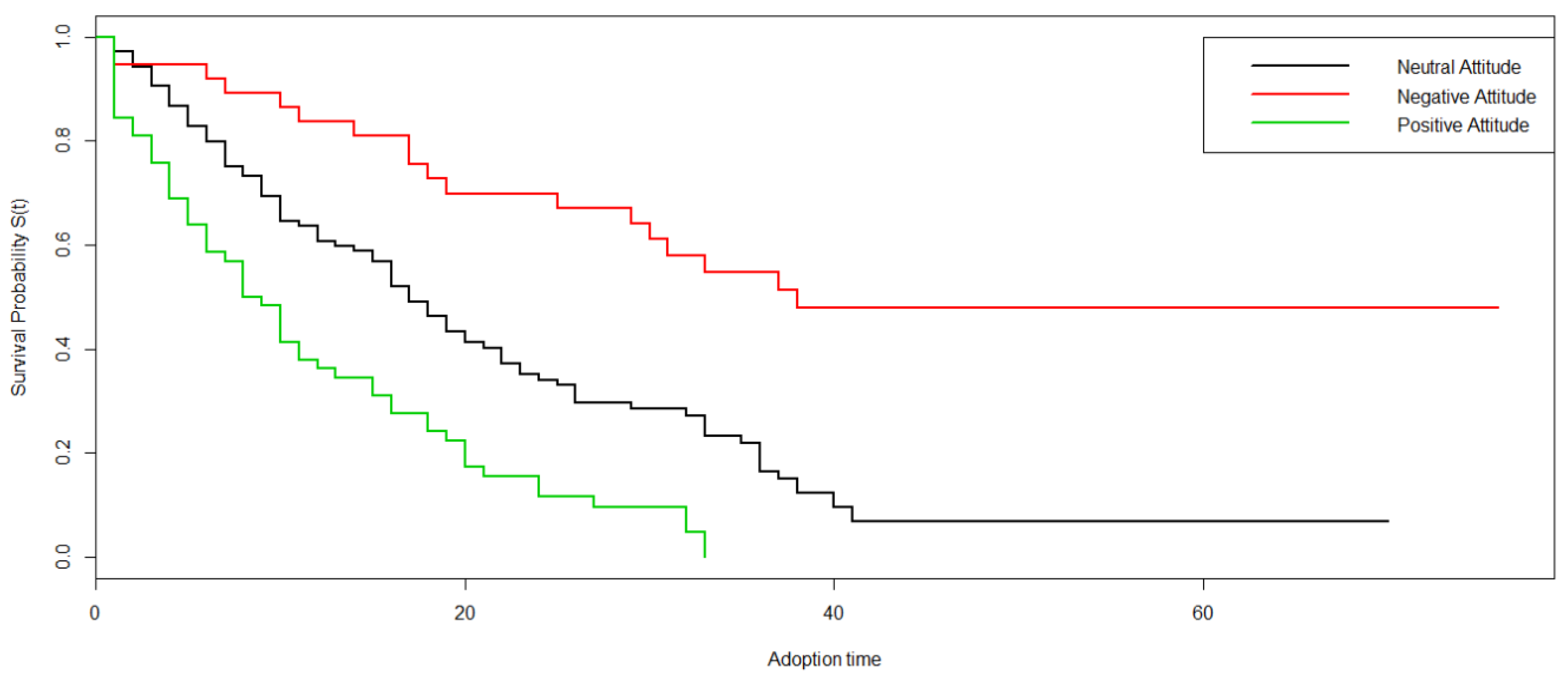
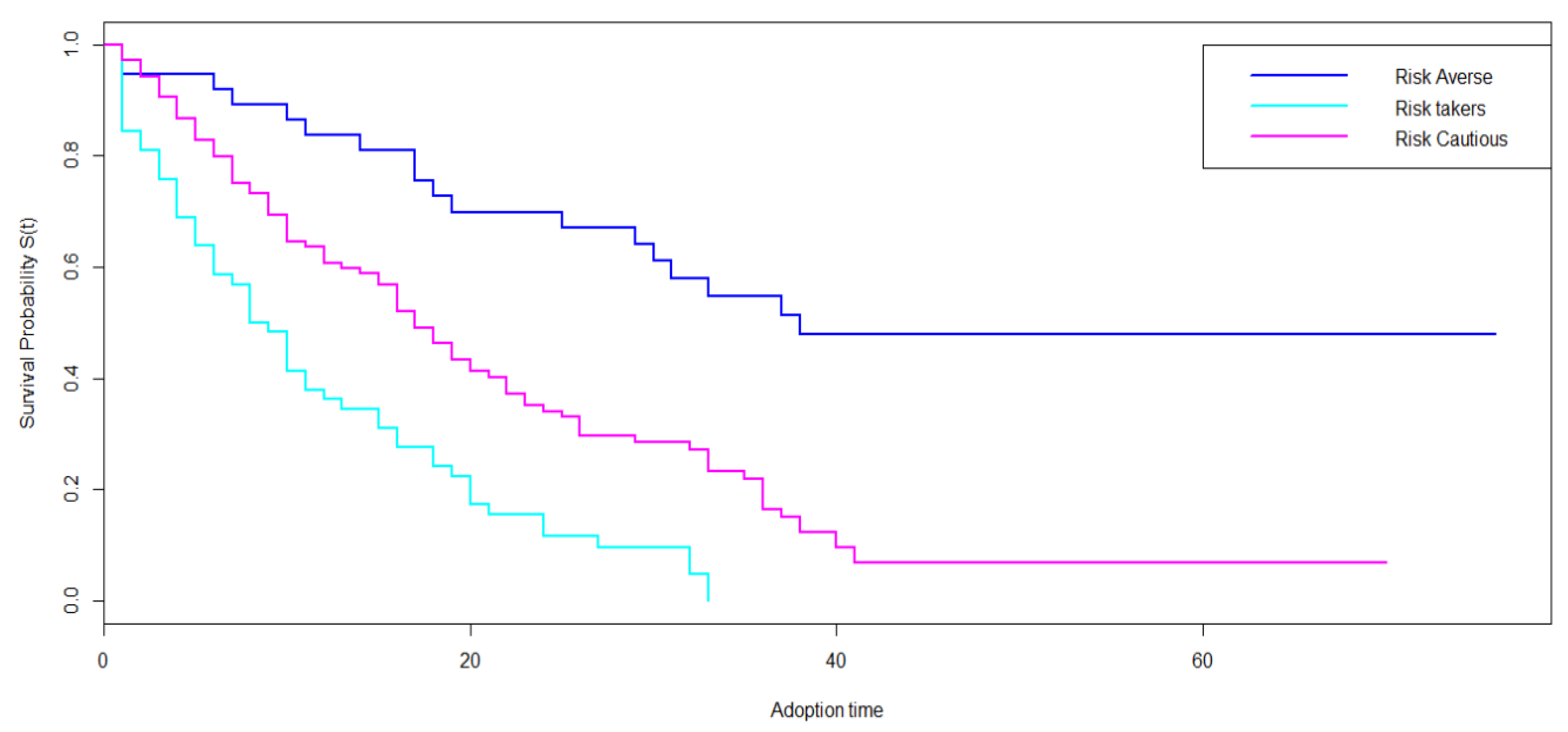
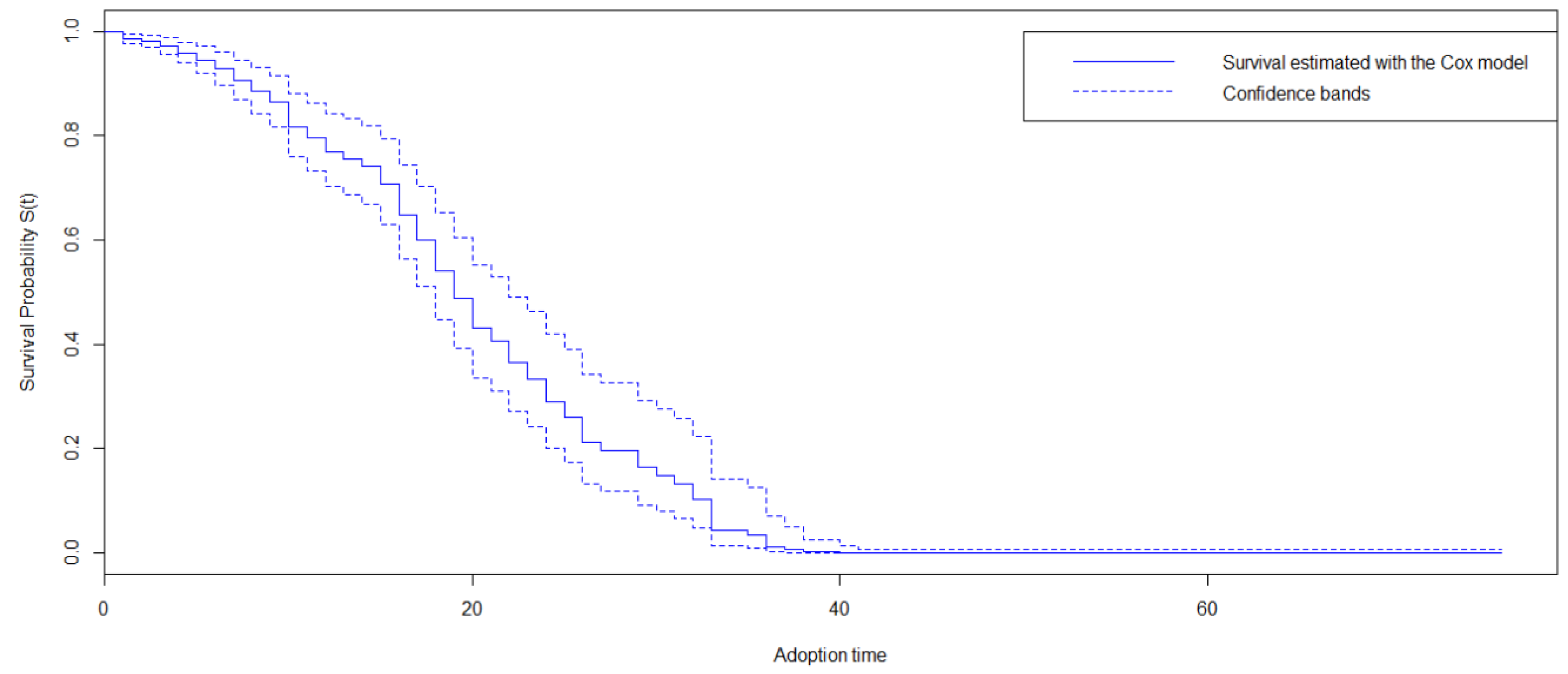
| Attitudinal Variables | References |
| The sale of improved maize prices to cover the higher production costs | [68] |
| Planting maize with improved seeds can ensure the future of farms | [69] |
| Seeding with improved maize seeds contributes to a positive image for the exploitation | [69] |
| Planting improved seeds with increased household income | [70] |
| Improved maize seeds have better market acceptance | [70] |
| The masa-tortilla relationship is greater with the improved seeds | [71] |
| Risk Variables | References |
| Risk from marketing is less with improved seeds | [72] |
| The risks from proliferation of pests and diseases are lower with improved seeds | [60,73] |
| There is less risk for lending to farmers with improved seeds | [60,73] |
| The risk from fluctuation is lower yields improved seeds | [74,75] |
| The risk from drought is less with improved seeds | [75,76,77] |
| The risk of losses due to frost is less with improved seeds | [75,76] |
| Variables | Confirmatory Factor: Potential Acceptance of Improved Maize Seeds |
| The sale of improved maize prices to cover the higher production costs | 0.85 |
| Planting maize with improved seeds can ensure the future of farms | 0.84 |
| Seeding with improved maize seeds contributes to a positive image for the exploitation | 0.83 |
| Planting improved seeds with increased household income | 0.82 |
| Improved maize seeds have better market acceptance | 0.81 |
| The masa-tortilla relationship is greater with the improved seeds | 0.77 |
| Cronbach’ Alfa: 0.882, KMO: 0.839, Bartrlet Test: 774.32 (0.000, explained variance: 68%, rotation method: Varimax | |
| Variables | Confirmatory Factor: Risk Aversion |
| Risk from marketing is less with improved seeds | 0.87 |
| The risks from proliferation of pests and diseases are lower with improved seeds | 0.82 |
| There is less risk for lending to farmers with improved seeds | 0.81 |
| The risk from fluctuation is lower yields improved seeds | 0.79 |
| The risk from drought is less with improved seeds | 0.78 |
| The risk of losses due to frost is less with improved seeds | 0.21 |
| Cronbach’ Alpha: 0.795, KMO: 0.767, Bartrlet Test: 613.85 (0.000), explained variance: 56%, rotation method: Varimax | |
| Covariates | Variable Description | Censored (n = 39) | Adopters (n = 161) | Total (n = 200) | |||
|---|---|---|---|---|---|---|---|
| Mean | Std. | Mean | Std. | Mean | Std. | ||
| Dependent Variable | |||||||
| Duration | Number of Years from Farmer Is Responsible for Planting Maize Until His Adopt | ||||||
| Explanatory Variables | |||||||
| Household head age | Age of the farmer in years | 75 | 9 | 51 | 11 | 56 | 15 |
| Reform NAFTA | Dummy variable to measure the effects of NAFTA introduced in 1994 (0: Before NAFTA, 1: after NAFTA) | 1 | 0 | 1 | 0 | 1 | 0 |
| Education | Education of farmers (0: illiterate, basic education, secondary education; 1: higher education) | 0 | 0 | 1 | 0 | 1 | 0 |
| Information | The way by which was known technology (1: technology met by a technician, 0: by a farmer) | 0 | 0 | 1 | 0 | 1 | 0 |
| Members | Number of members in the household (Continued) | 6.4 | 1.2 | 3.5 | 1.0 | 4.0 | 1.6 |
| Family workers | Number of family workers (man –equiv.) | 2.4 | 0.7 | 1.0 | 0.8 | 1.3 | 2.4 |
| Family member with university education | Number of family member with university education (0: No, 1: Yes) | 0 | 0 | 1 | 0 | 1 | 0 |
| Generations in agriculture | Number of generations in agriculture (Continued) | 3.7 | 2.0 | 3.5 | 1.0 | 3.5 | 1.2 |
| Generations in planting maize | Number of generations in planting maize (Continued) | 3.8 | 1.9 | 2.9 | 0.6 | 3.0 | 1.1 |
| Another crop | Having other crops (0: No, 1: Yes) | 0 | 0 | 0 | 0 | 0 | 0 |
| Aid received | Aid received by the government (0: No, 1: Yes) | 0 | 0 | 1 | 0 | 1 | 0 |
| Potential acceptance of improved maize seeds (segmentation results) | Attitudes towards improved maize seeds 1: Neutral attitude the improved seeds, 2: negative attitude towards the improved seeds, 3: positive attitude towards the improved seeds) | 2 | 1 | 2 | 1 | 2 | 1 |
| Risk attitude (segmentation results) | risk averse (1: risk averse, 2: cautious about risk, 3: risk loving) | 2 | 1 | 2 | 1 | 2 | 1 |
| Courses | Technology courses taken (0: No, 1: Yes) | 0 | 0 | 1 | 0 | 1 | 0 |
| Hectares | Number of hectares planted with maize (Continued) | 2.2 | 0.7 | 5.2 | 3.4 | 4.6 | 3.3 |
| Yield | Tonnes per ha | 2 | 0 | 4 | 1 | 4 | 1 |
| Sales | Sales of maize in Mexican pesos (Continued) | 2646.2 | 1331.4 | 21,948.2 | 23,857.2 | 18,235.3 | 22,732.8 |
| Economic objective | Relative importance of the economic objectives | 1 | 0 | 1 | 0 | 1 | 0 |
| Socio-cultural objective | Relative importance of the socio-cultural objectives | 0 | 0 | 0 | 0 | 0 | 0 |
| Environmental objective | Relative importance of the environmental objectives | 0 | 0 | 0 | 0 | 0 | 0 |
| Variables | β | e (β) | p Value |
|---|---|---|---|
| Household head age | −1.22 | 0.29 | 0.000 *** |
| Number of generations in agriculture | 0.22 | 1.25 | 0.050 ** |
| NAFTA reform (year 1994) | −1.86 | 0.15 | 0.000 *** |
| Number of family workers | −0.37 | 0.68 | 0.000 *** |
| Courses for best farming practices | 1.65 | 5.25 | 0.000 *** |
| PCA: Perception factor for accepting improved seeds | 0.44 | 1.55 | 0.001 ** |
| PCA: Risk behaviour (risk lover) | 0.45 | 1.57 | 0.010 * |
| Pseudo R2 | 0.76 | ||
| Likelihood ratio test | 286.8 | ||
| Wald | 187.1 | ||
| Score (logrank) test | 254.3 | ||
© 2018 by the authors. Licensee MDPI, Basel, Switzerland. This article is an open access article distributed under the terms and conditions of the Creative Commons Attribution (CC BY) license (http://creativecommons.org/licenses/by/4.0/).
Share and Cite
Sánchez-Toledano, B.I.; Kallas, Z.; Palmeros Rojas, O.; Gil, J.M. Determinant Factors of the Adoption of Improved Maize Seeds in Southern Mexico: A Survival Analysis Approach. Sustainability 2018, 10, 3543. https://doi.org/10.3390/su10103543
Sánchez-Toledano BI, Kallas Z, Palmeros Rojas O, Gil JM. Determinant Factors of the Adoption of Improved Maize Seeds in Southern Mexico: A Survival Analysis Approach. Sustainability. 2018; 10(10):3543. https://doi.org/10.3390/su10103543
Chicago/Turabian StyleSánchez-Toledano, Blanca Isabel, Zein Kallas, Oscar Palmeros Rojas, and José M. Gil. 2018. "Determinant Factors of the Adoption of Improved Maize Seeds in Southern Mexico: A Survival Analysis Approach" Sustainability 10, no. 10: 3543. https://doi.org/10.3390/su10103543
APA StyleSánchez-Toledano, B. I., Kallas, Z., Palmeros Rojas, O., & Gil, J. M. (2018). Determinant Factors of the Adoption of Improved Maize Seeds in Southern Mexico: A Survival Analysis Approach. Sustainability, 10(10), 3543. https://doi.org/10.3390/su10103543





